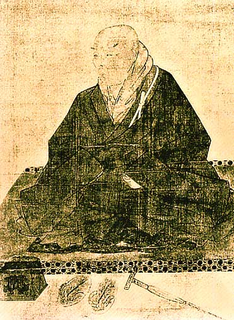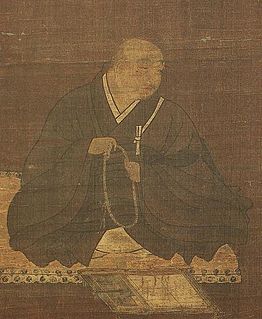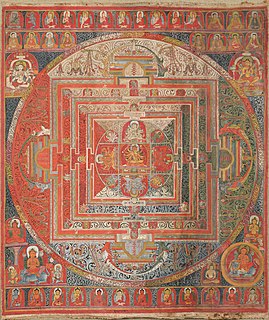
Shinran was a Japanese Buddhist monk, who was born in Hino at the turbulent close of the Heian Period and lived during the Kamakura Period. Shinran was a pupil of Hōnen and the founder of what ultimately became the Jōdo Shinshū sect in Japan.
Jōdo Shinshū, also known as Shin Buddhism or True Pure Land Buddhism, is a school of Pure Land Buddhism. It was founded by the former Tendai Japanese monk Shinran. Shin Buddhism is considered the most widely practiced branch of Buddhism in Japan.

Ippen Shōnin was a Japanese Buddhist itinerant preacher (hijiri) who founded the Ji-shū branch of Pure Land Buddhism.

Rennyo was the 8th Monshu, or head-priest, of the Hongan-ji Temple of the Jōdo Shinshū sect of Buddhism, and descendant of founder Shinran. Jodo Shinshu Buddhists often referred to as the restorer of the sect. He was also known as Shinshō-in (信証院), and posthumously Etō Daishi (慧灯大師). During the conflict of the Ōnin War and the subsequent warfare that spread throughout Japan, Rennyo was able to unite most of the disparate factions of the Jodo Shinshu sect under the Hongan-ji, reform existing liturgy and practices, and broaden support among different classes of society. Through Rennyo's efforts, Jodo Shinshu grew to become the largest, most influential Buddhist sect in Japan.

Buddhist liturgy is a formalized service of veneration and worship performed within a Buddhist Sangha community in nearly every traditional denomination and sect in the Buddhist world. It is often done one or more times a day and can vary amongst the Theravada, Mahayana, and Vajrayana sects.
Myōe (1173–1232) was a Japanese Buddhist monk active during the Kamakura period who also went by the name Kōben, and contemporary of Jōkei and Hōnen.

Chion-in in Higashiyama-ku, Kyoto, Japan is the headquarters of the Jōdo-shū founded by Hōnen (1133–1212), who proclaimed that sentient beings are reborn in Amida Buddha's Western Paradise by reciting the nembutsu, Amida Buddha's name.

Bukkō-ji, also known as the "Temple of the Buddha's Light", was originally named Kosho-ji, a Jōdo Shinshū temple in the Yamashina ward of Kyoto, which later moved to the heart of Kyoto. The temple was founded and officially opened by a disciple named Ryōgen in 1324, but by the 15th century, Bukkō-ji was the largest and most successful temple, and its network of branch temples extending throughout the provinces of western Japan. As a rival to the Hongan-ji, it received much criticism for its evangelical practices from Kakunyo the head of the Hongan-ji. Around 1481, however, Bukkō-ji became a subordinate temple to the Hongan-ji. Many of the Bukkō-ji's congregation thus became members of the Hongan-ji, thus greatly reducing the stature.

For other temples by similar names, see Zenrin-ji.
Kenjōdo Shinjitsu Kyōgyōshō Monrui (顕浄土真実教行証文類), often abbreviated to Kyōgyōshinshō (教行信証), is the magnum opus of Shinran Shonin, the founder of the Japanese Buddhist sect, Jodo Shinshu. The title is often translated as The True Teaching, Practice, and Realization of the Pure Land Way in English. The work was written after Shinran's exile, and is believed to have been composed in the year 1224. It represents a synthesis of various Buddhist sutras in Mahayana literature, including the Larger Sutra of Immeasurable Life, the Nirvana Sutra, the Avatamsaka Sutra and the Mahaprajñaparamita Sutra. In this way, Shinran expounds Jodo Shinshu thought. The work is divided into six chapters, not including the Preface:

Kakuban, known posthumously as Kōgyō-Daishi (興教大師) was a priest of the Shingon sect of Buddhism in Japan and credited as a reformer, though his efforts also led to a schism between Kogi Shingon-shū and Shingi Shingon-shū. Kakuban is also famous for his introduction of the "esoteric nembutsu".
Benchō, is considered the second patriarch of the main Chinzei branch of the Jōdo-shū sect of Japanese Buddhism, after Hōnen. He is often called by another name: Shōkōbō Benchō (聖光房弁長) or just Shōkō. According to biographies, he first ordained as a priest of the Tendai sect at the age of fourteen, and entered Enryaku-ji temple in 1183. He first met Hōnen in 1197. Later, after Hōnen and many of his followers were exiled in 1207, Shōkō was exiled on the island of Kyūshū and taught the practice of the nembutsu there.
The Senchaku Hongan Nembutsushū (選択本願念仏集), abbreviated to Senchakushū, is the magnum opus of Hōnen, founder of the Jōdo-shū school of Japanese Pure Land Buddhism. The title means "Passages on the Selection of the Nembutsu in the Original Vow" and draws upon past Pure Land Buddhist sources, sutras and especially from the writings of Chinese Pure Land Buddhist Shan-tao to bolster Hōnen's doctrine of relying upon the sole recitation of Amitabha Buddha's name for rebirth in the Pure Land. Hōnen also asserts for the first time that he is establishing a new school of Buddhism.
The term Ōjō is a term in Japanese Buddhism for rebirth in the Pure Land of Amitabha Buddha. Sometimes the term is expressed as Ōjō gokuraku. The subject of how to obtain birth in the Pure Land remained an important question throughout Japanese Buddhist history even until today.
The Jodo Shinshu Buddhist Temples of Canada are a group of temples and fellowships that are affiliated with the Nishi Hongan-ji of Kyoto, Japan, the mother temple of the Jodo Shinshu sect of Buddhism.
Kōsai was a former monk of the Tendai Buddhist sect and controversial disciple of Hōnen who advocated the ichinen-gi that led to his public censure, his later expulsion by Hōnen and eventual exile to Shikoku. Kōsai taught that one recitation of Amitabha Buddha's name, the nembutsu, would be sufficient for rebirth in the Pure Land, and that further recitations would indicate a lack of faith on the part of the believer. Thus, he taught a path strictly based on faith without any Buddhist practice, which drew criticism from established Buddhist sects at the time, and even Hōnen's other disciples.












